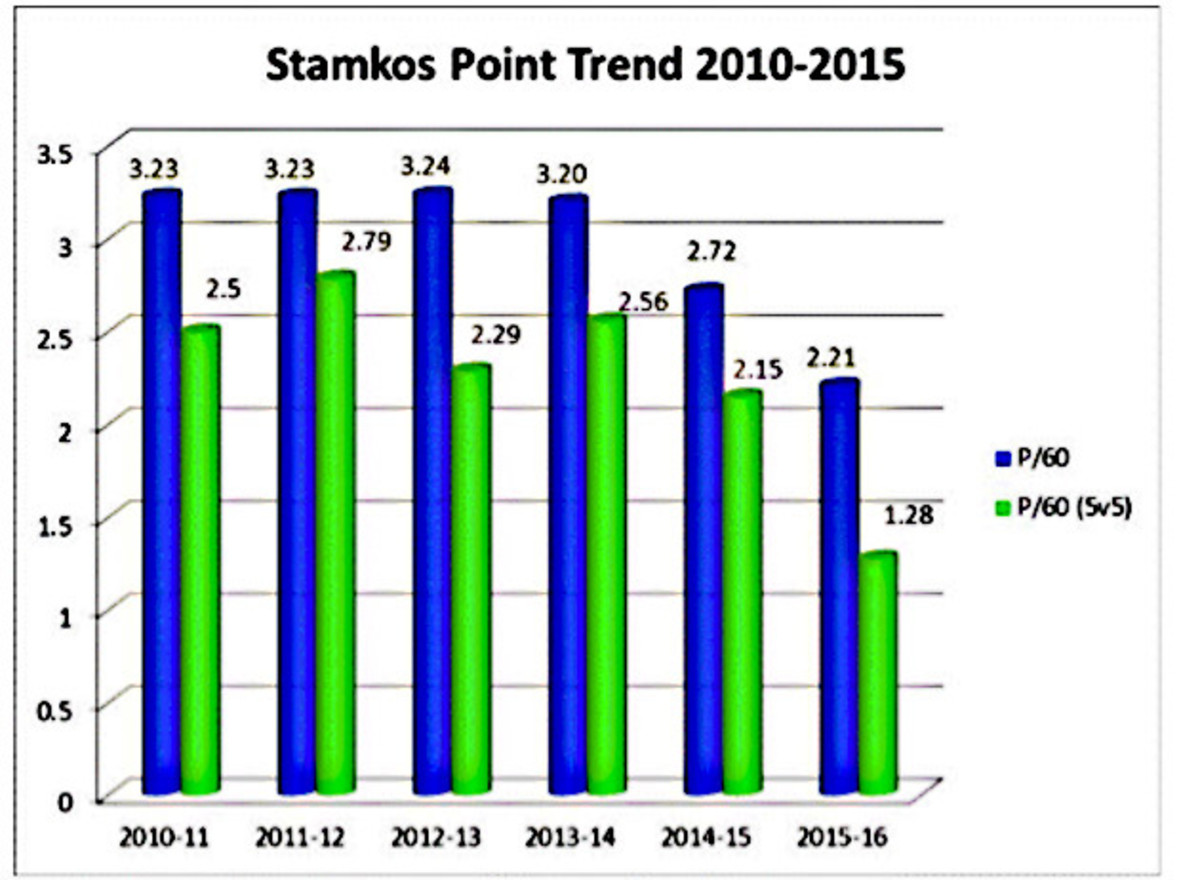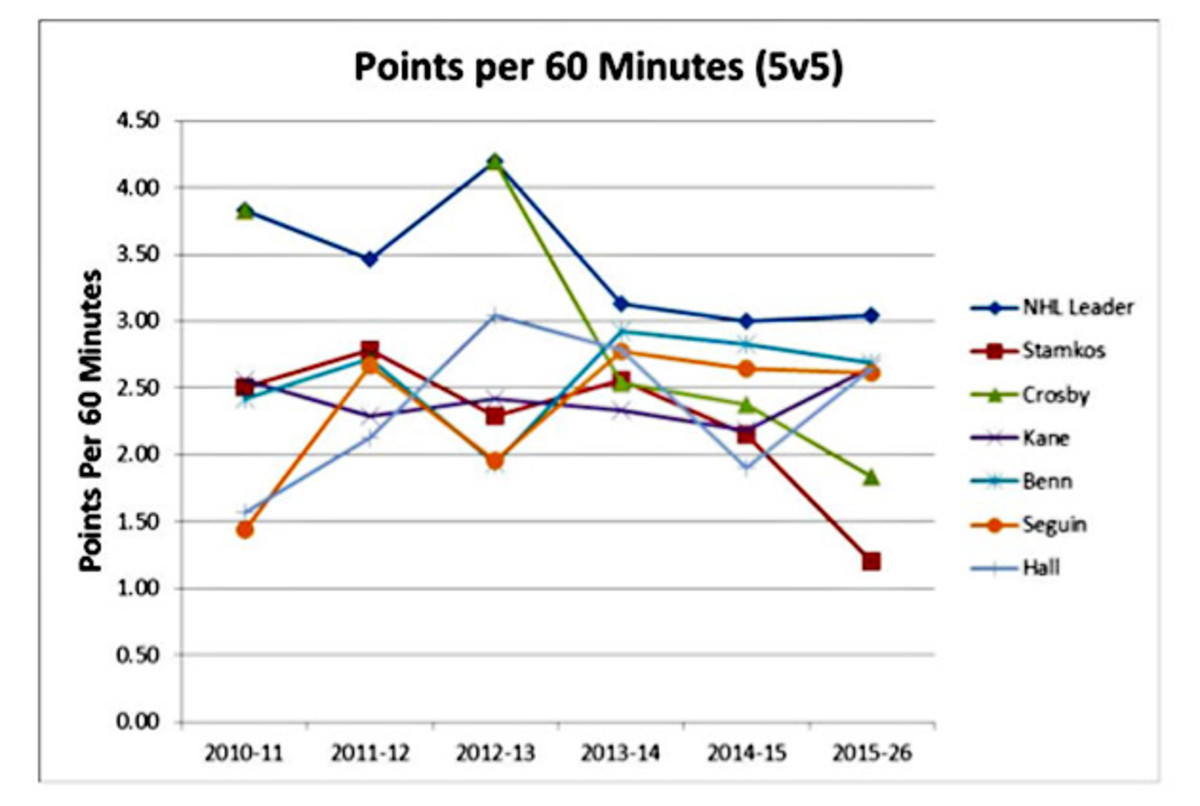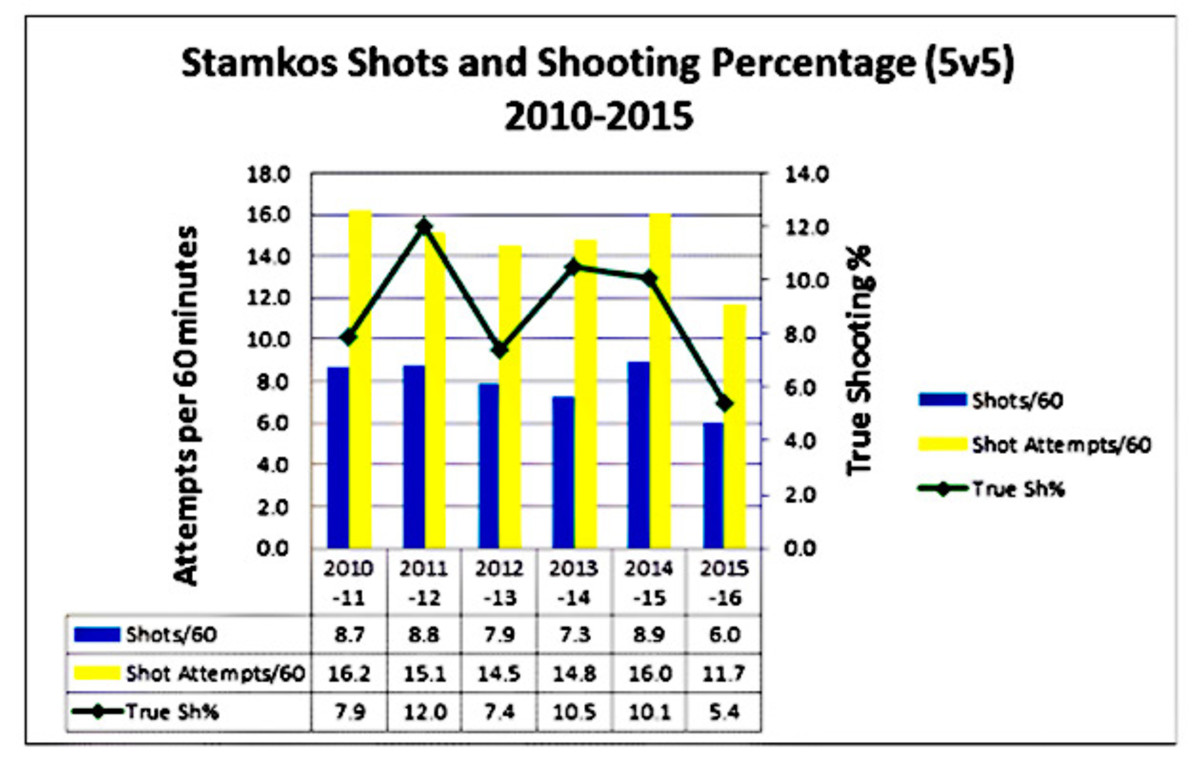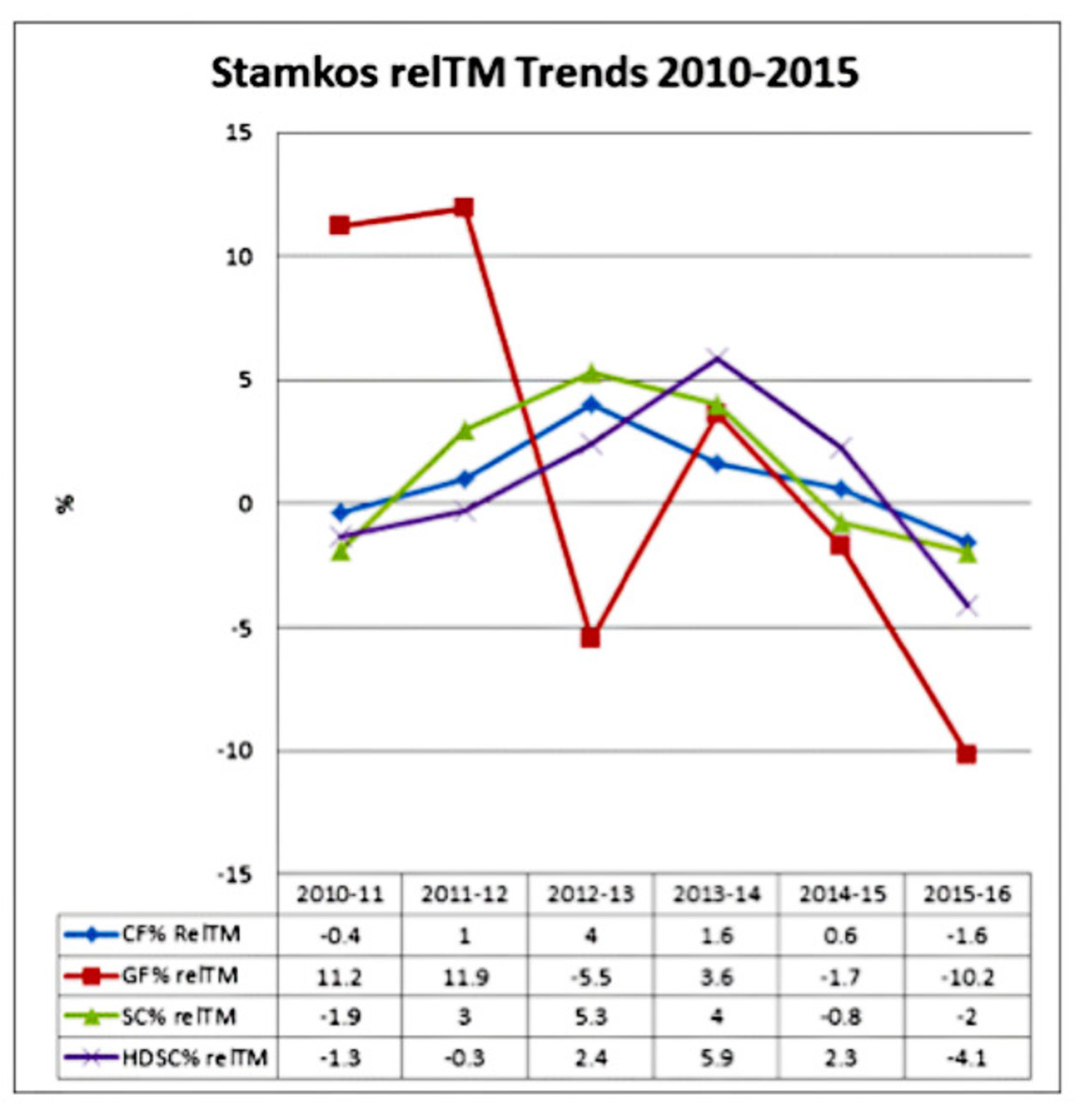How much is Steven Stamkos worth?

One of the hot topics in the NHL is what will happen when (if) former 60-goal scorer Steven Stamkos hits the free agent market at the end of this season.
At the tender age of 25, Stamkos has been arguably the best sniper in the game during the past six or so seasons. After being a key component of the Lightning’s Stanley Cup Final run last season, and in an era of parity unlike any ever seen in any major professional sports league, many teams believe that adding Stamkos could be the difference that delivers a championship. Organizations including the St. Louis Blues, Anaheim Ducks, Montreal Canadiens, his home town Toronto Maple Leafs, and others, have been eagerly awaiting the opportunity to bid on his unique skill set.
But with Stamkos reportedly seeking an annual salary north of Jonathan Toews’ and Patrick Kane’s $10.5 million per season, and with a salary cap that seems to get tighter every year (consider the core players that teams like the Blackhawks and Bruins had to move during the past off-season), signing any player to a long-term contract at $11 or $12 million per is a risky proposition.
Is Stamkos worth it?
To answer that question the main consideration is what we can expect his productivity to be going forward.
• Most likely free agent destinations for Stamkos
Ordinarily, at age 25 a player of Stamkos’s ability and track record would be right in his prime, with at least five years of top-tier productivity ahead of him. But as shown by the graphs below, his performance during the last two years has seen a sharp downturn that teams need to take seriously.
The first two graphs show Stamkos’s total productivity as measured in points per 60 minutes (P/60). After maintaining an elite, and remarkably consistent, output for the four seasons starting in 2010, his numbers have fallen off a cliff, with his 5-on-5 production so far this season only half of what he averaged from 2010-14.

* All stats in this article are from War-on-Ice.com and Puckalytics.com.
The second graph (“Points per 60 Minutes”) shows how Stamkos’s productivity has stacked up against other elite forwards. Although his production was at or above most of the other top players until the 2014-15 season, starting last year he fell far behind. This season, Stamkos ranks just 210th among the 303 forwards who have played more than 300 minutes at 5-on-5.

No doubt, those numbers aren’t good. But how worried should teams be? Even 40 games into a season a player’s point totals may be more a function of puck luck than an accurate reflection of his play. The next two graphs speak to that concern.
The “Stamkos Shots and Shooting Percentage Graph” shows his shots per 60 minutes, shot attempts per 60 minutes, and “true shooting percentage” (goals divided by total shot attempts). The results are surprising. For starters, Stamkos is attempting about 30% fewer shots this season. But perhaps even more puzzling, an even smaller proportion of those shot attempts are going on net (6.0 on net out of 11.7 attempted per 60 minutes), and his true shooting percentage has also fallen sharply, to a career low 5.4%.
If the smaller number of shot attempts were a function of Stamkos becoming more selective, then we’d expect his shooting percentage to go up. Just the opposite has happened. This suggests that not only is he generating fewer shot attempts, but the quality of those attempts is lower than in years past.
Analysts generally look at a shooting percentage below a player’s historical average as an opportunity to “buy low” on a player who will return to form (e.g. as we predicted with Radim Vrbata a couple of years ago. But with Stamkos, there’s no buy low opportunity. Even if he produced at his 2010-14 levels, a team paying anything close to what he’s asking might be overpaying. More importantly, this doesn’t look like a case of a temporary productivity decline that we should expect to return to historical levels. As reflected by the drops in the number of shot attempts and scoring chances generated, the problem looks to be deeper, more fundamental, and possibly more permanent.

That Stamkos’s productivity drop may not be temporary is confirmed is by the final graph below—“Stamkos RelTM Trends 2010-2015”—which shows four separate “RelTM” stats (i.e., how Stamkos stacks up against his team’s average). The four stats are (1) shot attempt percentage (CF%); (2) goals for percentage (GF%); (3) scoring chance percentage (SC%); and (4) high danger scoring change percentage (HDSC%).
The sharp downward trajectories of all four lines of the graph track the drop in his points production, which strongly indicates that his lack of output isn’t only a function of bad puck luck.

So, pretty much all of the numbers show a worrisome decline over the past two seasons. What they don’t tell us is why that decline has happened—which would provide insight into whether the decline is likely to continue. To that question we don’t have the answer. It could certainly be a function of Stamkos playing more time on the wing than in years past, or of different linemates, or the lingering effect of his nasty broken leg in late 2013, a bad fit with coach Jon Cooper’s systems, and/or a number of other possibilities.
But if you’re paying $12 million, then, regardless of what the explanation is, you’re making a very expensive bet that whatever it is that’s affecting Stamkos won’t be there next season and beyond. To be sure, Stamkos’s numbers haven’t been helped by the substitution of long-time linemateMartin St. Louis with a declining Ryan Callahan on his opposite wing and a mix of serviceable centermen (VladislavNamestnikov, Alex Killorn, and ValtteriFilppula). But for $12 million, a guy with Stamkos’s ability should be able to score pretty much every time he sneezes, whether his linemates are Gretzky and Lemieux or the Hanson Brothers. And you wouldn’t think that some playing time on the wing would have anywhere close to the impact we’re seeing. Finally, if health is a concern, then that’s a whole other set of issues. In other words, none of the possible explanations is particularly comforting for teams that are considering blowing a huge part of their cap on a single player.
Does that mean teams should give up on Stamkos altogether?
Lightning have plenty of options in dealing with frustrated Drouin
to a big five or six year deal that will expire by the time the Leafs’ prime prospects hit free agency, which means that even if he craps out, Lou Lamoriello and Company might still have enough cap space to build a very good team.
The Ducks, meanwhile, have had a puzzlingly frustrating season so far. And although it was a bit bewildering to imagine why aging defenseman Kevin Bieksa was on their “must have” list this summer, they still have a lot of key pieces locked up at reasonable cost, and adding even a diminished Stamkos would surely help their scoring woes.
The Lightning, Blues, and Canadiens, on the other hand, are looking to win now and have a core of top-tier players who will be hitting unrestricted free agency within the next three years. Signing Stamkos to a monster contract would almost certainly mean that those clubs will have to sacrifice one or more of their current key pieces. For teams looking to win the Cup this season, deciding which of those key players to keep (or add) and which to let go can make all the difference.
What is clear is that the risks associated with signing Stamkos to a huge deal are much greater than they were two years ago, and they seem to be growing every game. If you think Stamkos is “The Guy” then maybe it wouldn’t be crazy to pay $11 or $12 million for him. And maybe a team that is swinging for the fences will be willing to risk striking out given his potentially organization-changing upside. But unless there’s something we don’t know about his health (that isn’t long-term), it looks more and more like he’s at best a 40-goal man with only limited ability to deliver in other departments. Under no scenario does that command a salary north of $10 million.
If Stamkos reaches free agency you can bet that some team will be all too eager to overpay. That team will probably end up regretting it. In an auction situation, like one where teams bid on free agents, the team that “wins” the auction, and gets the free agent, does so because it pays more than any other team believes he’s worth. In the case Steven Stamkos, if he can’t regain his old form then this “winner’s curse” could end up being fatal to the title hopes of whichever team ends up signing him.
The Department of Hockey Analytics employs advanced statistical methods and innovative approaches to better understand the game of hockey. Its three founders are Ian Cooper (@Ian_doha), a lawyer, former player agent and Wharton Business School graduate; Dr. Phil Curry (@Phil_doha), a professor of economics at the University of Waterloo; and IJay Palansky (@IJay_doha), a litigator at the law firm of Armstrong Teasdale, former high-stakes professional poker player, and Harvard Law School graduate. Visit us online at www.depthockeyanalytics.com
